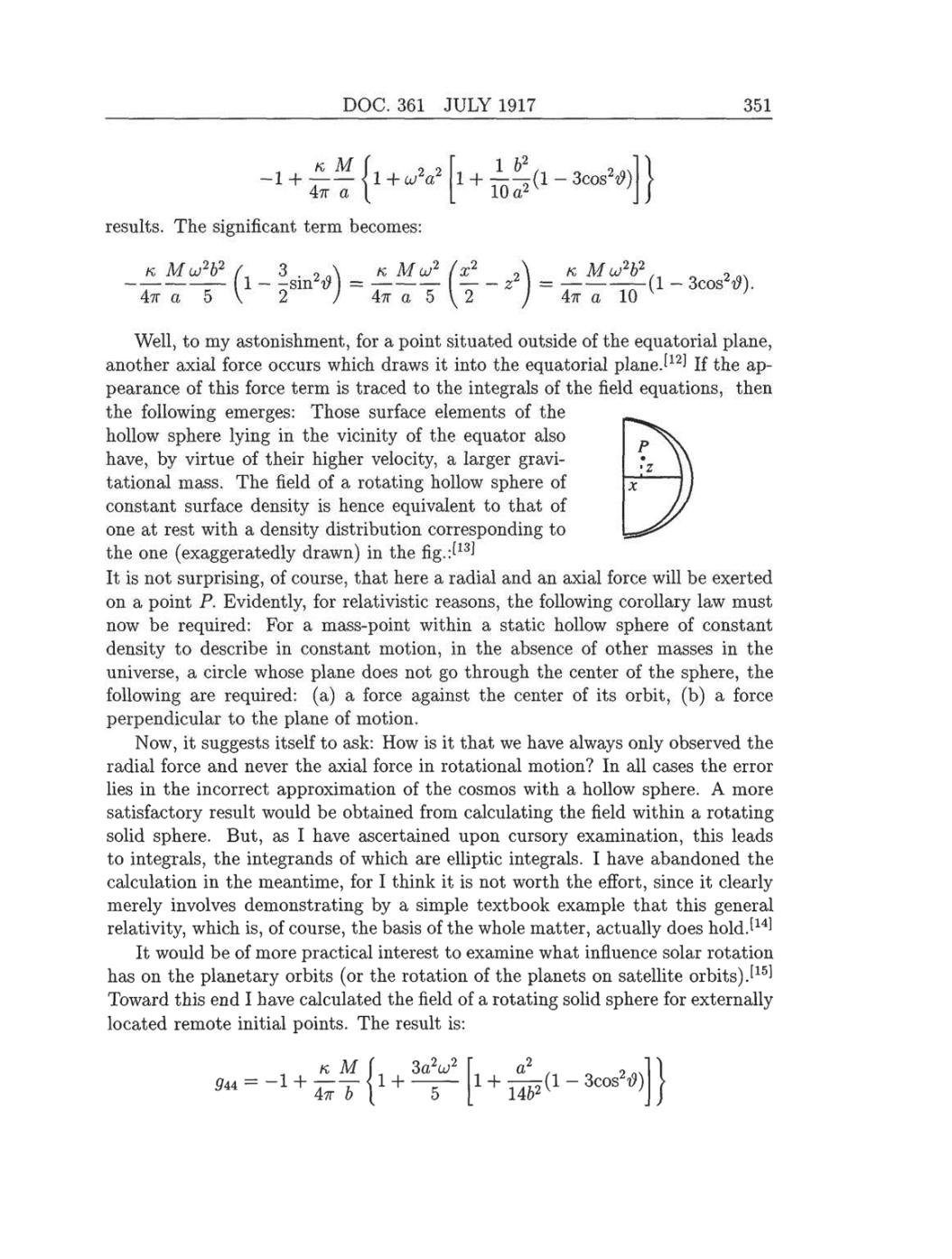DOC.
361
JULY
1917 351
k_M
47r a
1+07
2 2
a
results.
The
significant
term becomes:
k
Mu2b2
47T a
5
k
Mw2
/a:2
47T a
5
\
2
k
M
u2b2
47T a
10
(1
-
3cos2$).
Well,
to
my astonishment,
for
a
point
situated
outside
of
the
equatorial
plane,
another
axial force
occurs
which draws it into
the
equatorial
plane.[12]
If
the
ap-
pearance
of
this
force term is
traced
to
the
integrals
of
the
field
equations,
then
the
following emerges:
Those surface elements of
the
hollow
sphere lying
in the
vicinity
of
the
equator also
have, by
virtue of
their
higher
velocity, a
larger gravi-
tational
mass.
The
field
of
a
rotating hollow
sphere
of
constant surface
density
is
hence
equivalent
to
that
of
one
at rest with
a
density
distribution
corresponding
to
the
one (exaggeratedly drawn)
in
the
fig.:[13]
It
is
not
surprising,
of
course,
that
here
a
radial
and
an
axial
force will
be exerted
on a
point
P.
Evidently,
for relativistic
reasons,
the
following
corollary
law must
now
be
required:
For
a mass-point
within
a
static
hollow
sphere
of constant
density
to
describe in constant
motion,
in the absence
of
other
masses
in
the
universe,
a
circle whose
plane
does not
go
through
the
center of
the
sphere,
the
following
are
required: (a) a
force
against
the
center
of its orbit,
(b) a
force
perpendicular
to
the
plane
of
motion.
Now,
it
suggests
itself
to ask: How is
it that
we
have
always only
observed
the
radial
force and
never
the
axial
force
in
rotational
motion? In all
cases
the
error
lies
in
the
incorrect
approximation
of
the
cosmos
with
a
hollow
sphere.
A
more
satisfactory
result would be obtained from
calculating
the
field
within
a
rotating
solid
sphere.
But,
as
I
have ascertained
upon cursory examination,
this
leads
to
integrals,
the
integrands
of
which
are elliptic integrals.
I have
abandoned the
calculation in
the
meantime,
for
I
think it
is not
worth
the
effort,
since it
clearly
merely
involves
demonstrating
by
a
simple
textbook
example
that this
general
relativity,
which
is,
of
course,
the
basis
of
the whole
matter,
actually
does
hold.[14]
It would be of
more
practical
interest to
examine
what influence solar rotation
has
on
the
planetary
orbits
(or
the rotation
of
the
planets
on
satellite
orbits).[15]
Toward
this
end
I
have calculated
the
field of
a
rotating
solid
sphere
for
externally
located remote
initial
points.
The result
is:
k
M
f
3a2u2
941
=
_1+4ÏT
1
+
_5~
1
+
îijîfl
-
